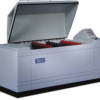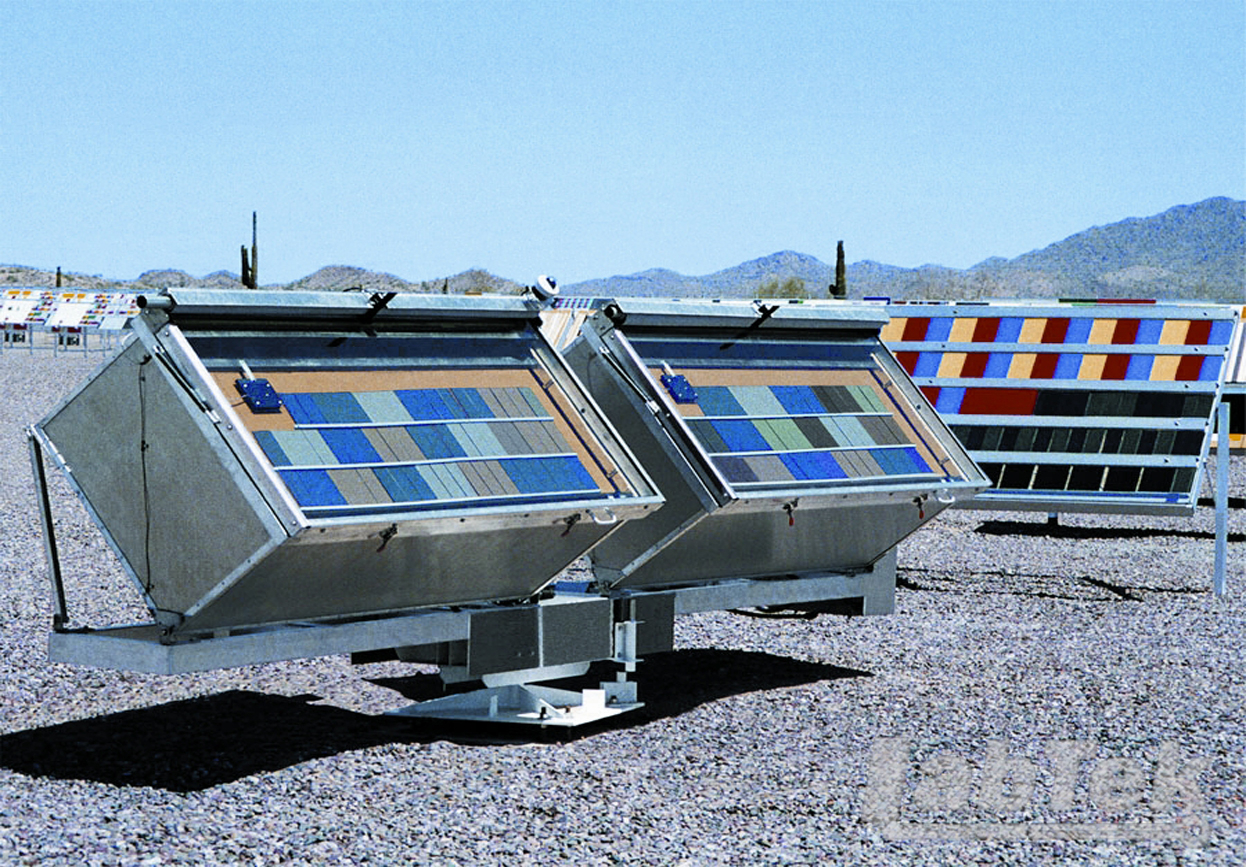Accelerated, Natural Results
AIM Boxes are under-glass enclosures that simulate the sunlight and heat found inside an automobile. These important environmental stressors result in color change, cracking, peeling, oxidation, or loss of strength of materials in car and truck interiors. AIM boxes can accelerate these stressors by tracking the sun throughout the day. AIM boxes are suitable for mounting large components like instrument panels, seat cushions, and steering wheels. Small, flat specimens can also be mounted to test samples like interior trim.
AIM box testing is highly affordable, and available at Q-Lab’s ISO 17025 accredited facilities in Florida and Arizona.
Realistic Simulation
Testing automotive interiors can be different from testing other materials because air temperatures inside a vehicle can far exceed the temperature outside it. Materials can reach 100°C or more in warmer climates. Furthermore, the light that reaches internal components is filtered by automotive glass, making it different from natural sunlight. This changes the light spectrum that must be tested for in order to achieve a realistic result.
The environment inside an AIM box is carefully controlled. A black-panel sensor monitors the temperature inside the box. At a pre-determined temperature set point, fans turn on to cool the specimens, creating a precise and realistic testing environment.
Some AIM boxes can perform precision azimuth tracking of the sun throughout the day. As a result, specimens are exposed to more solar radiation which results in faster tests without sacrificing accuracy.
Test Methods
AIM box testing from Q-Lab meets a variety of automotive industry test methods, a portion of which are shown below. Visit our Standards Page or contact Q-Lab for a more complete list.
- GM 2617M, 3619M, 7454M, 7455M, 9538P
- GMW 3417
- Ford DVM 0020
- ASTM G201
Different types of glass can be specified in order to meet different standards.
Q-Lab conducts all exposure tests and evaluations in accordance with appropriate test methods from ASTM, ISO, BSI, DIN, JIS, SAE, and other recognized organizations, in accordance with ISO 17025.
Typical Test Times
| Automotive Part Description | Temp (◦C) |
TNR (Langleys) |
Typical AZ Time (Months) |
| Instrument Panel (Upper Horizontal Surface) | 102 | 100,000 | 6 to 7 |
| Instrument Panel (Lower, Above Door Glass Line) | 85 | 30,000 | 3 to 4 |
| Trim Panel: Door/Quarter (Door Glass Line and Armrest) | 85 | 50,000 | 5 to 6 |
| Trim Panel: Door/Quarter (Lower; Vertical Surface) | 85 | 5,000 | < 1 |
| Garnish Moldings (Pillar; Horizontal Surface) | 93 | 75,000 | 7 to 8 |
| Garnish Moldings (Pillar; Vertical Surface) | 85 | 50,000 | 5 to 6 |
| Garnish Moldings (Pillar; Above Door Glass Line, Vertical) | 85 | 40,000 | 4 to 5 |
| Garnish Moldings (Pillar; Below Door Glass Line, Vertical) | 85 | 5,000 | < 1 |
| Seats/Head-Restraint (Rear Seat) | 102 | 105,000 | 7 to 8 |
| Seats/Head-Restraint (Front Seat) | 93 | 40,000 | 4 to 5 |
| Steering Wheel/Column Trim (Rim Upper Surface) | 93 | 55,000 | 5 to 6 |
| Steering Wheel/Column Trim (Horn Pad, Column & Shroud) | 85 | 15,000 | ~2 |
| Consoles, Top | 93 | 30,000 | 3 to 4 |
| Consoles, Sides | 85 | 10,000 | 1 to 2 |
| Assist Handles and Overhead System Components | 85 | 10,000 | 1 to 2 |
| Rear Window Trim Panel | 102 | 105,000 | 7 to 8 |
| Open Rear Cargo Area, Vertical Glass, Components (At Sidewall) | 93 | 50,000 | 5 to 6 |
| Open Rear Cargo Area, Vertical Glass, Components (Floor Level) | 85 | 15,000 | ~2 |
Cost-Effective
AIM boxes produce real-world results in a fraction of the time of natural exposures. This means that new formulations or products can be brought to market faster, saving time and effort. Additionally, Q-Lab’s AIM box testing services are extremely affordable – programs start at less than the cost of a cup of coffee per day.


